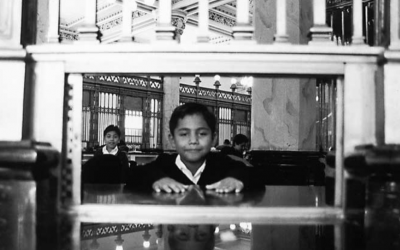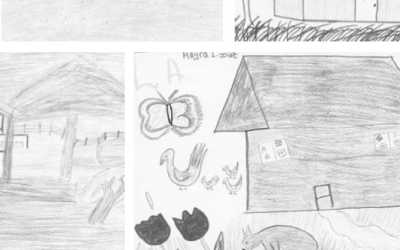Of the People, By the People, For the People
Grassroots in rural El Salvador

Left to right: Yanira del Carmen, Jáquilin Lis- seth, and Rosa Elvira at the Copante kinder. Rosita is currently undergoing multiple plastic surgeries to correct the birth defect that left her without a functioning right ear. Photo by Ilille Sawady
The children gather around me in a circle on the floor. I show them the small silver tape recorder and microphone I had promised to bring to class in this most rural of communities in El Salvador. Their eyes open wide with excitement.
At first, many of the boys and girls hold back. They are initially too shy to come forward and speak into the microphone to record their voices, but once a few children step forward, I am swarmed with 35 two-to-six-year-olds, clambering to get a word in edge-wise. They introduce themselves, talk about what they like to do in the kinder, and sing songs. They plead to hear the recordings over and over again, giggling every time they hear their own voice.
“Buenos días niños! (Buenos Días!) Yo me llamo Patricia Yanira del Caserío La Presa”
“Me llamo Milton. Vengo de Caserío Copante. Vengo a jugar y a pintar y escribir”
“Yo me llamo Íngrid Esperanza Luna Pérez y me gusta trabajar”
“Yo me llamo Glenda Soledad, me gusta estudiar”
“Buenos días yo me llamo Nereyda Marisol. Me gusta jugar con los juguetes de cocina y jugar la plastilina [play-dough]”
“Buenos días! Yo me llamo Meylin Xiomara que vivo en Naranjera y me gusta escuchar cuentos”
These children attend school in one of the five comprehensive early childhood development centers (Centros Infantiles del Desarrollo Integral, or CIDIs), also known as kinders, run by La Asociación Campesina para el Desarrollo Humano (CDH), a grassroots community health, education and development organization in the rural communities of Estancia, El Salvador. The local campesinos formed CDH three years ago to continue the health, education and capacity-building work done by the French nonprofit organization, Mèdicins du Monde (MDM).
CDH determined what work needed to be done in the community based on its strategic plan developed through in-depth discussions with communities about their needs, perceptions of services, and areas for further growth. In addition to their work with the CIDIs, CDH runs La Clínica CAIPES (Centro de Atención Integral para la Prevención y Educación en Salud). Since 1998, this clinic has brought comprehensive health care to the people of the region, making medical services accessible both geographically and culturally.
The communities in which CDH works straddle the Río Torola in the department of Morazán, one of the poorest regions of El Salvador that was devastated by the brutal 12-year-long civil war that ended in 1992. Mass graves filled with women and children have been discovered in the surrounding communities. Many of the peasants currently living in the area spent much of the war as refugees in camps in Honduras. Most lost one or more family members to the war and many were disabled as a result of the conflict.
Prior to the civil war, those living in rural Morazán had no access to education or health care. Those who are now working on the project were able to receive a smattering of education in refugee camps and in settlements during times of relative peace. However, no one’s education went beyond the second-grade level.
Ten years ago, José Ramiro Cortéz Argueta had a second-grade education and did not have enough money to buy shoes or to replace torn pants. Today, Ramiro is the Executive Director of CDH. He has completed a high school equivalency degree and become a respected community leader, a health promoter with great clinical acumen, and the director of one of El Salvador’s most promising community organizations. Victorino Sanchez, the project’s administrator, has completed one year of university education, is Microsoft Excel savvy and composes eloquent formal letters for the organization. María Santos, María Isabel, Ana, Marilú, Isidra and Lucia, the six local community educators, have completed or are currently working on their high school degrees. They have participated in training sessions held at El Salvador’s Universidad de Centro America (UCA) and are well-versed in early childhood education theory and practice.
The community educators work in the five CIDIs, which were formed in 1993, to help two- to six-year-old children deal with the traumatic psychological effects of the war and to provide them with nutritious meals. Not only were the CIDIs able to provide these children with previously unavailable educational opportunities, but they were also safe havens that helped normalize their childhood experiences. Over the past 10 years, the CIDIs have expanded their mission to include all aspects of child health and development. They have made tremendous strides towards reducing childhood malnutrition. They have helped children make successful transitions into school and have provided them with opportunities to learn how to read and write.
“Mi escuelita yo lo quiero…Una maestra se llama Rebecca. Otra maestra se llama María Santos. Otra maestra se llama María Luisa. Y todas ellas trabajan en un kinder de popularia y que nos dan clases a los niños que hemos aprendido letras mucho y también a bailar.
Una niña que siempre anda con granitos [skin infections] que se llama Cindy [Lorena’s younger sister] y la otra niña que ha andado con estos granitos es Glenda y ¡esa niña es mi prima!”
— LORENA ARELÍ MARTINEZ MARTINEZ,
CASERÍO TIERRA BLANCA
The CIDIs are staffed by six well-trained community educators—all of whom have been working in the centers for six to ten years—and five Ministry of Education teachers. The CIDIs are affiliated with programs from many local, national, and international organizations, including the Ministry of Health, the Ministry of Education, the UN World Food Programme, the Salvadoran NGO Medicos por el Derecho a la Salud, and Doctors for Global Health.
The area in which CDH works faces many challenges. Roads are often difficult if not impossible to pass, especially in the rainy season. The government does not maintain the roads in the area, so road repair is done by groups of CDH-organized volunteers, usually local campesinos. To get to the nearest town, people must walk 30 to 90 minutes up steep slopes to the closest bus stop and then take the bus that sporadically travels to town. Furthermore, no bridges cross the river that separates CDH from two of the communities served by the project. In the dry season, the river is low enough to cross by foot. In the rainy season, however, people use two unreliable suspension cables to transport themselves across the river. Those children wishing to obtain beyond a first-grade education level must make this commute every day to school. Transportation for health emergencies relies on a 1992 Toyota Hilux with 250,000 miles on it, locally known as el anciano. Such a ride costs 150 colones ($17.14) in gas (plus car maintenance), a sum that is beyond the reach of many people in the area. Because CDH is concerned with providing necessary services to the local population, the organization pays for many of these rides out of its limited general operating funds.
The past year has been a challenging one for CDH as it struggles to establish itself as a Salvadoran NGO with legal standing and to obtain sufficient funding and support to continue serving its communities. Despite these obstacles, the CIDIs have been able to continue offering children of the community access to high-quality early childhood development opportunities which were not previously available. Three-yearold Alba, who is most likely deaf, is one of the many children benefiting from CDH’s early childhood health and development programs. Although Alba doesn’t speak, she communicates avidly with gestures, and is easily seen to be extremely intelligent and developing well in other areas. However, unless she learns sign language or lip reading soon, it will be extremely difficult for her to develop adequate communication skills. CDH and its partner organizations are helping to coordinate specialist hearing and speech evaluations for Alba with a pediatric audiologist in San Salvador. Without this help, such an endeavor would be completely out of reach for her impoverished family. Alba’s struggles are not over. She has many difficult years ahead of her. Through ongoing support from her family, the community educator, the local health promoter and CDH, Alba and others like her will have the opportunity to reach their full potential.
Despite all of these challenges, the project’s potential is enormous. CDH is a uniquely empowering organization run by the people of rural Morazán, for the people of rural Morazán. With solidarity and support, it will make a real difference.
Winter 2004, Volume III, Number 2
Rebecca Sawady spent six months working with CDH this past summer/fall as a volunteer through Doctors for Global Health (DGH), funded through grants from DRCLAS, the Center for International Development and the Department of Population and International Health at HSPH. Rebecca is studying international health as a masters student at Harvard School of Public Health, where she is continuing her own professional development so that she will be able to better serve marginalized communities in rural Latin America. For more information about the project and how to become involved, please see DGH’s website www.dghonline.org or e-mail Rebecca at rsawady@hsph.harvard.edu.
Related Articles
Editor’s Letter: The Children
A blue whale spurts water joyfully into an Andean sky on my office door. A rainbow glitters among a feast of animals and palm trees. Geometrical lightning tosses tiny houses into the air with the force of a tropical hurricane.
Centroamerica
Cuando Pedro Pirir, fue despedido del taller mecánico donde trabajaba desde hacía muchos años, experimentó una sensación de injusticia y pena que luego se transformó en una voluntad…
Irregular Armed Forces and their Role in Politics and State Formation
As I sat in heavy traffic in the back of a police car during rush hour in the grimy northern zone of Rio de Janeiro, I studied the faces of drivers in neighboring cars, wondering what they thought of…




